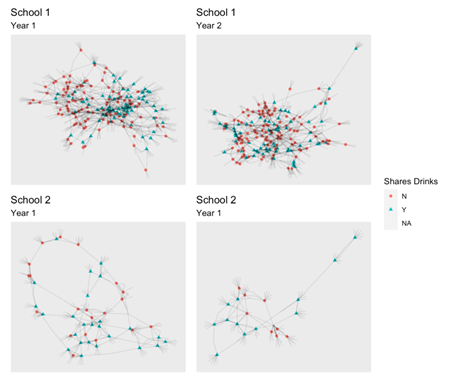“I am not being individual on me own” – How do social networks drive transmission of infectious disease?
Posted on April 21, 2023 by Andrew Conlan
Andrew Conlan takes us behind the scenes of his latest publication "Colonization and transmission of Staphylococcus aureus in schools: a citizen science project" published in Microbial Genomics.
My name is Andrew Conlan, I am an Associate Professor in Epidemiology at the Department of Veterinary Medicine, University of Cambridge.
Our shared experience living through the SARS-CoV-2 pandemic has perhaps made everyone a little too aware of the role and importance of mathematical models in predicting the patterns of spread of infectious disease and informing policy decisions on control. Most of my research is motivated by using such models to address specific public or animal health policies. However, building epidemic models requires an understanding of the patterns of contact within populations and how social factors and mobility shape the opportunities for transmission.
Almost every model used to inform choices on the introduction and use of vaccines in human populations depends in some way on the use of self-reported social networks. Effectively these come from questionnaire surveys where we ask (mostly adults) the ages of people they routinely make contact with over a typical day. The details of how frequently different age-groups mix with each other can have profound impacts on predictions of the impacts of control measures – in particular vaccines. However, the mechanistic link between individuals (self-reported) networks and networks of transmission of pathogens has never been directly checked.
Having worked for over ten years with secondary school children as citizen scientists to measure social networks within schools we saw the opportunity to address this question by measuring the association (if any!) between social networks and carriage of a commensal bacterium. We choose to study Staphylococcus aureus, as there was a lack of information on the prevalence of carriage of this organism (which also has clinical importance as an opportunistic pathogen) in school age children. The little evidence available suggested that carriage rates should be higher within a school, giving the opportunity to isolate and sequence a large number of bacteria from which we could potentially infer networks of transmission using genomics.
Unfortunately, despite confirming a higher carriage of S. areus in school-age children than the general community, we found very little evidence of transmission links within our two partner schools. This suggests that school is not the primary setting for transmission of these bugs. A big surprise was that despite past projects in schools having extremely high recruitment rates (> 90%), we struggled to get less than half of this when asking students to carry out swabbing. This suggests that even with high levels of engagement, there is a basic floor on the willingness to participate in such transmission studies which should be factored into designs.
One of the questions designed by the school children was more successful. They asked students if they had a preference to share drinks with each other and found that girls, but not boys, were more likely to be contacts with others who shared the same preference. From the survey we can’t tell whether this behaviour informs children’s choice of friends, or is re-enforced within friendship groups. However, this type of core-group behaviour – where individuals with the same behaviours or social characteristics cluster together – is important in amplifying the risk of transmission. While we found no link to transmission of S. aureus in schools, sharing preferences may give some insight into how friendship networks evolve (or how they shape behaviour) – a really cool observation we wouldn’t have made without the guidance of our citizen scientists.

As a mathematician who works in a veterinary school on a range of human and animal study systems, very few days are the same. My role across projects is to use mathematics and statistics to make the most of sparse data, improve the design of experiments and explore the potential policy implications of new observations and results. As such, I work with a diverse range of people and across disciplines from wet-lab microbiologists, field epidemiologists, ecologists, economists, social scientists through to the high school students and teachers from this project. Engagement is, I would argue, an essential part of epidemiology as our research is both of and has direct impact on the public. My work with schools is by far the most enjoyable and rewarding part of my job.

